Editorial: Best solution is missing for home on BLM land
Published 12:00 am Friday, May 25, 2018

- Jeff Kitchens, BLM district manager for the Prineville District, in the Juniper Acres subdivision outside Alfalfa.
The more we learn about the Bureau of Land Management’s plan to resolve about 17 acres of public land with a private home on it, the worse it gets.
The BLM says it wants to do right by the public. But it has failed. It failed to resolve the matter within any kind of reasonable timeframe. It’s been 10 years since the BLM found out about the private home built on public land southeast of Prineville. The BLM failed to be open about what it was doing. It declined to release the names of the parties involved. And now that the BLM has offered alternatives to resolve the issue, many of the proposed solutions are not that great for the public.
The whole thing has been a mess from the beginning. In 1995, a home was built on BLM land southeast of Prineville, sort of along the road to Post. It’s not clear how that happened. Bend business partners Charles McGrath and Jennipher Grudzien got involved in 2008. The two co-founders of Bend’s Grace Bio-Labs Inc., bought 5,000 acres from Robert and Peggy Watson for $2.5 million. It included the 2,500-square-foot log home, two barns, a greenhouse, a windmill, buried utilities and a road to get there.
Greg Lynch, the attorney for McGrath and Grudzien, says McGrath went to the BLM shortly after the property purchase and told officials he was concerned the home was on public land. He was right. The home, outbuildings, buried utilities and the road to it are on public land.
This is where things get more interesting. Did McGrath and Grudzien suspect the home was on BLM land before they bought it?
The BLM says yes, according to its recently released environmental assessment. It says the “landowner” stated during a BLM surveyor’s investigation in 2008 that “he became suspicious approximately three days prior to the sale closing that the house may have been on public lands.” The BLM says that was in the surveyor’s notes.
Lynch says: “That is complete bull…..” He said his clients didn’t suspect anything until after the sale when discussing other property with a real estate agent.
Another interesting issue is why McGrath and Grudzien would not then go back to the Watsons and demand at least some of their money back.
Lynch told us the Watsons were willing, at the time, to rescind the purchase and return to McGrath the money paid to acquire the property.
Lynch wrote McGrath and Ludzien didn’t because McGrath got assurances from the BLM in 2008 that he would be able to keep the land and buildings after buying the land from the BLM.
In hindsight, that seems a big gamble.
2009 went by. 2010. 2011. 2012. Frankly, not much happened.
In 2013, McGrath sent the BLM an email. “I understand that you are very busy, but five years does seem like a very, very, very long time,” he wrote, adding that “we need to make this happen as quickly as possible and not drag it out for another five years.” And, of course, it has dragged on for another five years.
2014 went by. 2015. 2016. In 2017, the BLM made public that it intended to seek to resolve the issue, but didn’t make it easy for the public to understand what was happening. It released its statement with no map of the location and no names of the parties involved.
Earlier this week, the BLM released a range of possible solutions.
They include: no action; sale of one acre; sale of 17 acres; giving the owner a 30-year lease and then the BLM reclaims the property; and immediately reclaiming the property and requiring removal of the structures. One important question is if any property sale would be directly to McGrath and Grudzien or opened up to the general public.
That decision would be made after the BLM finalizes the action it will take.
Unfortunately, the best possible option is not on the list. That would be a land swap. McGrath and Grudzien own plenty of land in the area.
Surely, there is a plot that would be a fair exchange. The public would not lose any public land and they could keep the home without more hassles.
McGrath suggested a land swap five years ago. Those negotiations never went anywhere. The BLM rejected the idea. The BLM tried to interest the business partners in a land swap in February. Once again, the two parties could not agree. They should try again.
If that doesn’t work, the best option is to give the business partners a 30-year lease. They failed to adequately vet their purchase, and they declined to take up the Watsons’ offer to return their money.
Still, the BLM has not treated them well. This solution lets them use the home and the property. But it rightly keeps the public land in public hands.
Tell the BLM what you think about its plans. BLM officials say specifics and additional information are particularly valuable. Comments must be received in writing at the Prineville District office by 4:30 p.m. June 25.
Send emails to BLM_OR_PR_Mail@blm.gov with “Land Resolution” in the subject line.






